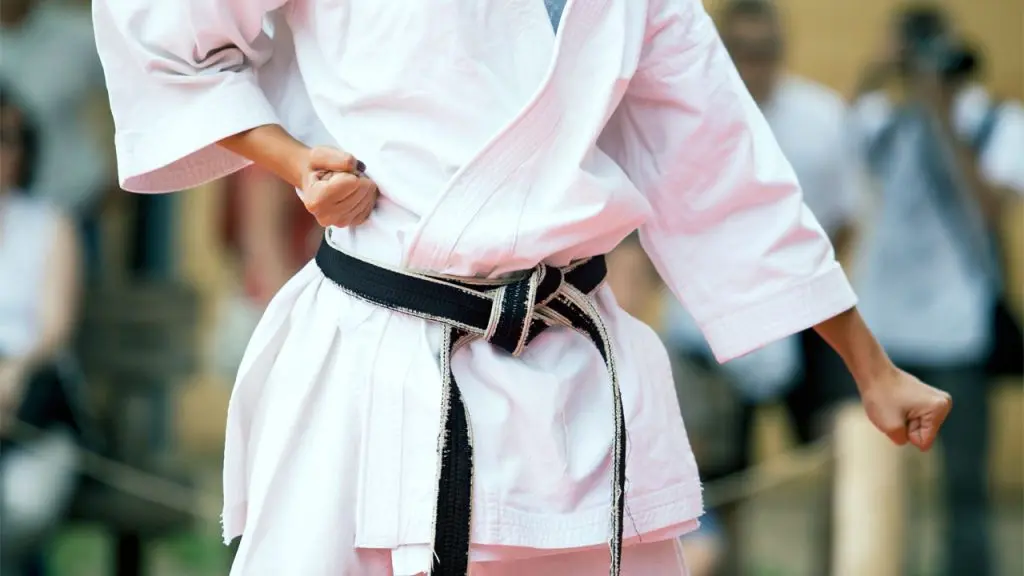Have you ever heard of the three Ks of Karate? They are Kihon, Kata, and Kumite. These three Ks are the three parts of Karate. Without them, Karate doesn’t exist.
Kihon, which means basics in Japanese, are the basic techniques. These are the punches, kicks, stances, and other techniques that all Karate students learn. However, these techniques won’t be much good to you unless you understand how to string them together for use in an actual fight.
That’s where kata and kumite in Karate come in. Each aspect is quite different from the other, but both are essential to your study as a Karate student. Let’s dive in and learn all about these important elements of Karate!
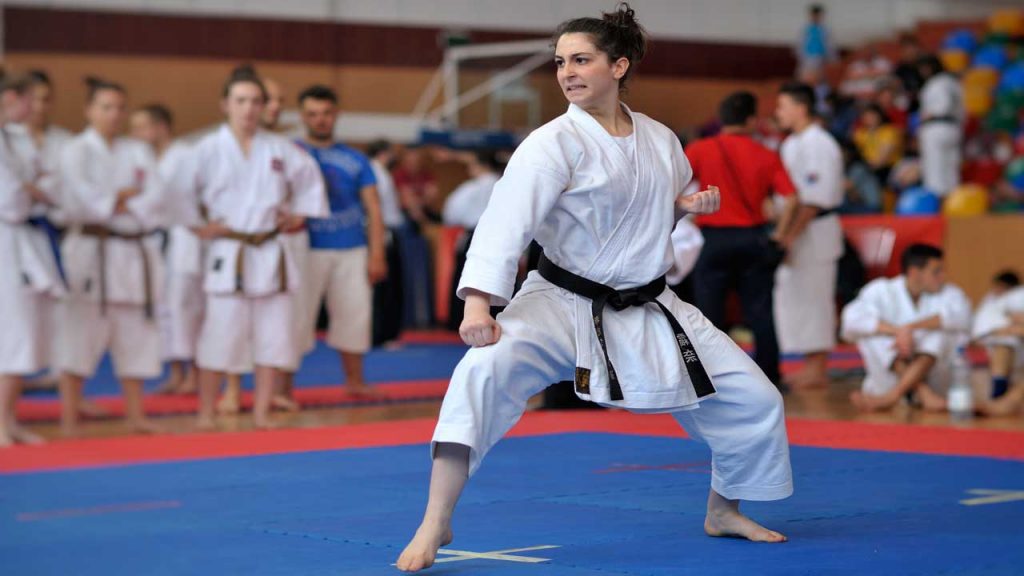
Table of Contents
- What Is Kata in Karate?
- How Are Katas Useful to Modern Day Karateka?
- Karate Kata Names
- Japanese Kata in Competition
- What Is Kumite in Karate?
- Is a Kumite Fight like a Real Fight?
- Kumite in Tournaments
- Kumite as Sport Fighting
- The Kumite in Bloodsport
- Karate Kata and Kumite in the Olympics
- Kata and Kumite in Karate
What Is Kata in Karate?
How did the ancient martial arts masters archive their techniques? As you might imagine, trying to express them in drawings or paintings was inadequate and they didn’t exactly have a video camera handy on their smartphone to make a recording.
This was how katas originally began. They were an organized archive of techniques that masters could more easily pass down to their students so that knowledge of these moves wouldn’t be lost. Though kata is an essential part of Japanese Karate, the idea of creating and using it as an archive originated with ancient Chinese Kung Fu masters.
In Japanese, the word “kata” means forms. Each one is a specific set of movements that are performed in the same way every time. Typically students must learn and perform at least one kata in order to graduate to the next belt level. There are katas starting from a white belt kata on up to advanced black belt katas.
Katas are very rigid and unchanging and every technique must be performed flawlessly. This rigidity makes sense because they’re supposed to stay true to the original form of each technique.
However, the kata moves are also ordered in a specific way that would make sense in a fight. In other words, many of the adjacent techniques in kata can be strung together and used successfully in a real fight.
How Are Katas Useful to Modern Day Karateka?
So, what’s the point of still using kata in the modern-day? Now we can take a video of each kata and maintain a library of techniques that way. In fact, many schools already do this, giving their students resources they can use when learning the katas.
However, kata is useful not only as a record of techniques. Learning each kata is an excellent exercise for the karate student both mentally and physically.
Practicing the kata over and over drills it into your brain, helping you to remember the techniques and how to execute them. You’re also expected to perform the moves flawlessly. You’re moving slowly, there is nothing coming at you at the moment, you should be able to do the move perfectly.
Why? Because practicing kata also drills the technique into your body, developing muscle memory. Perform the move correctly 1,000 times while practicing kata and you’ll perform it correctly when you need it in a split second for defense.
Of course, when you need a particular defensive move, you won’t be consciously thinking about the move you need. You don’t have time to decide you’re going to use the 6th move from a particular kata to defend against this attack. That’s where muscle memory comes in. As the attack comes, your body will move to react and defend itself using a move it has performed 4,695 times before when practicing your kata.
Furthermore, performing kata consistently helps build your physical conditioning. Stances in kata are often long and deep and you may have to hold it for a period of time. This builds strength and conditioning in the leg, core, and glute muscles.
In other words, katas are an essential part of modern Karate practice and it’s a safe bet to say it always will be.
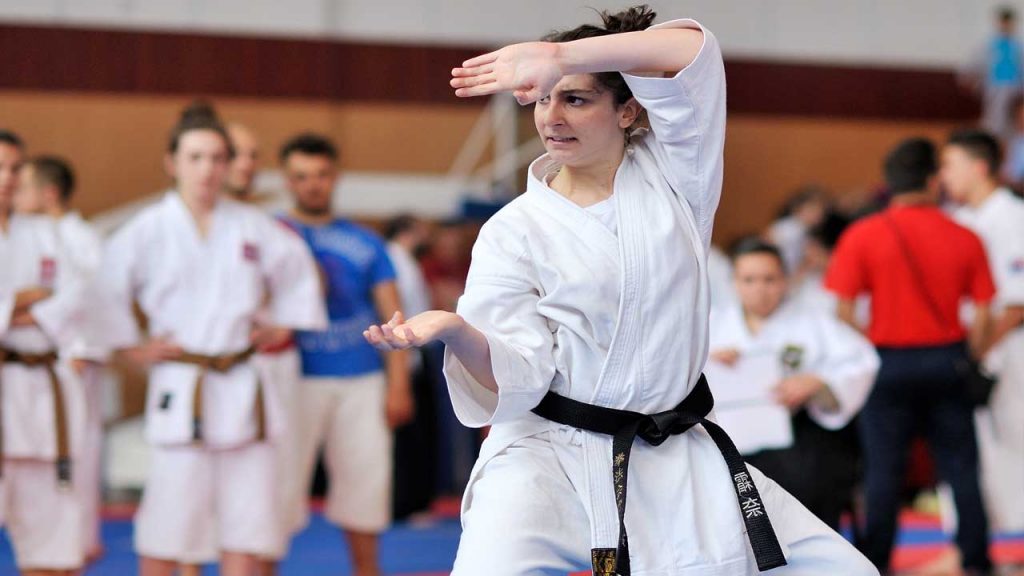
Karate Kata Names
Though there are many more katas in existence, there are 26 recognized Shotokan Karate katas. Each kata has a very practical name that refers to the basic type of moves that are performed in the kata. Let’s look at a few examples.
- Jitte: The name of this kata meaning is “10 hands” and the student is fighting 10 opponents
- Enpi: This name means “flying swallow” and the up and down movements are short and quick, darting about like a little flying bird
- Gankaku: The name means “crane on a rock” and the main stance used looks like a crane about to strike
- Chinte: This kata name means “rare hands” and uses rare circular techniques that are not typical of the more direct philosophy of Shotokan Karate
There are many more, but this list gives you an idea of how Karate kata names are used.
Japanese Kata in Competition
Though perhaps not as thrilling to watch as the sparring matches at a tournament, karate katas make an appearance in competitions as well and are still impressive to watch. The participant is judged not only on the flawlessness and strength of their technique but also their fighting spirit and focus (often referred to as attitude). Judging is based 70% on technique and 30% on athletic prowess. Curious about the detailed karate rules, check out this article.
Competitors usually compete in pairs. One wears a blue belt, the other a red. The 5-judge panel uses a blue and red flag system to choose the winner.
The World Karate Federation (WKF) approves a Karate kata list of 102 katas, though there are more in existence.
Check out Sandra Sánchez in female-kata action at the Karate OLYMPIC Tokyo 2021 here.
What Is Kumite in Karate?
Whereas kata is performed alone, kumite is used to give the Karate student practice fighting against a real opponent. Students are paired and allowed to use techniques against one another to better understand how a technique would work in a real fight. Many of the techniques learned in kata appear in kumite as the student puts into practice what they have learned.
There are various types of kumite. Students begin with the most basic and move up to freestyle kumite or “jiyu kumite”. The basic kumite in Shotokan Karate, gohon kumite, uses a five-step prearranged attack and defense/counter technique. This allows a beginner student to begin developing a feel for how to defend against a real attack.
Each type of kumite is progressively harder and less structured, thereby requiring the student to defend and attack without a pre-determined set of moves. Multiple attackers are also gradually introduced, helping the student develop an awareness of their surroundings, even amidst a fight. The most advanced type, as we mentioned, is jiyu kumite which most closely resembles a real fight.
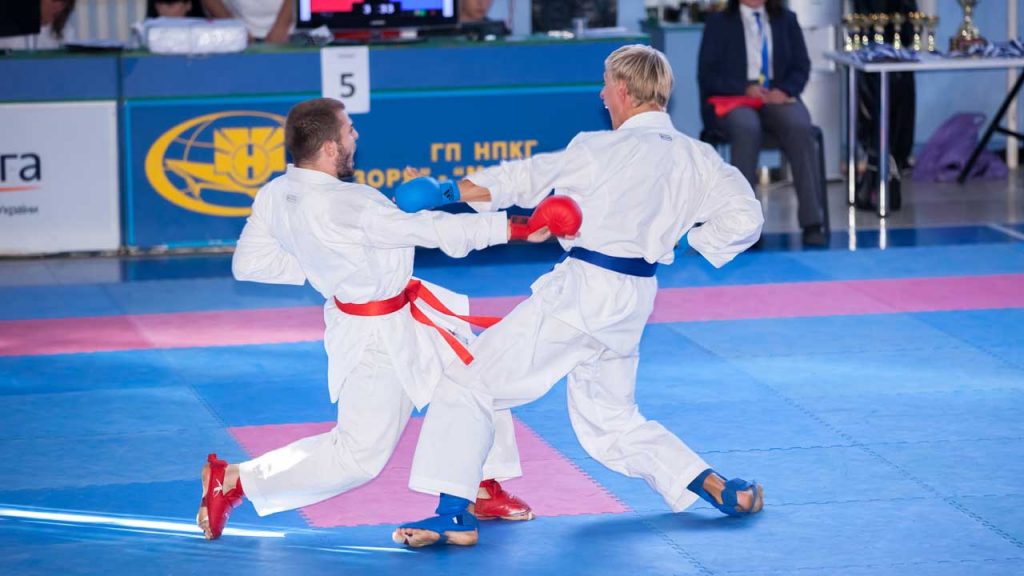
Is a Kumite Fight like a Real Fight?
Speaking of a real fight, can kumite ever be like a real fight? While kumite is a great simulation, it is almost never exactly like a real fight. There are a lot of other emotions (fear, anger, etc.) and sensations involved in a real fight that can’t be replicated in a dojo.
Furthermore, most schools encourage students to “pull their punches” in kumite. While students are encouraged to develop powerful techniques, these are usually reserved for punching bags and padded targets.
In a kumite match, the emphasis is placed more on precision and technique. Certain strikes, like groin, knee, and face strikes are often prohibited for lower ranks or until the student displays excellent precision and control. Obviously, neither practitioner is interested in getting injured in class.
To give students an opportunity to better understand a real karate fight, some schools will use protective gear during kumite to allow students to fight with more power. There are various pieces of gear that participants can use from shin and forearm protection to chest protection.
Other schools, particularly those run by more traditionalists, don’t view full-contact kumite as very useful. Fellow students will never really use all their power against one another, even with protective gear, because they are not interested in hurting one another. It is only in the midst of a real fight that a karateka’s full power and fighting spirit will come roaring forth.
However, there is a place for everyone. If you would prefer kumite fighting that is closer to a real fight, you might want to check out Kyokushin Karate. This is a somewhat brutal style of Karate that prides itself on not pulling punches and turning out hardened karate fighters.
Kumite in a Kyokushin dojo does not involve protective gear, nor are students encouraged to pull their punches. Instead, it is an all-out fight that is finished by knockout.
Kumite in Tournaments
In most Karate kumite competitions, strict rules are enforced to ensure the safety of the participants. Full-contact blows are typically only permitted to the torso. Blows to the head and abdomen are not permitted in some competitions or are restricted to senior-level participants only. When permitted, it is not common that full-contact is allowed.
The competition takes place in an 8-meter square “ring” in which the participants must stay during the course of the fight. If they step out of the ring once, they typically receive a warning. If they step out twice, their opponent gets a point.
Scoring is point-based in the majority of Kumite competition. To earn points, participants must land a punch or kick with proper form. One, two, or three points can be awarded depending on the type of technique.
A kumite round typically lasts for 3 minutes. To win, a participant must either reach 8 points within the 3-minute round or have the most points at the end of the round. If there is a tie, the first participant to have scored a point wins. If neither participant scores a point, judges determine the winner based on form.
Check out a demonstration of a kumite match here.
Kumite as Sport Fighting
Some karatekas criticize this type of fighting, saying it does not prepare fighters for the real world. It is sport fighting and that’s all it can be. The point of kumite is to land a blow with precision and control, not use full force to devastate your opponent, which is what Karate would be used for on the street. A kumite fighting style cannot be used for self-defense.
Regardless, kumite has its place in the Karate dojo. It is an excellent way to allow students to practice looking for ways to break through their opponent’s defense as well as learn to react quickly in their own defense. Plus, you don’t have to worry quite so much about people getting injured during class.
However, for those looking for something a bit more realistic, Kyokushin classes and tournaments are always an option. Though there are still tournament rules that must be obeyed, they promote knockdown and full-contact fights that are touted to be closer to the real thing.
The Kumite in Bloodsport
If you are a fan of martial arts movies (check out this list of classics if you are), you may be wondering about the Kumite in Bloodsport. The 1988 movie starring Jean Claude van Damme followed the story of real-life Frank Dux who was supposedly invited to a clandestine tournament called The Kumite.
An interview with the real Frank Dux uncovers that the movie didn’t 100% follow what really happened. For example, he says that he fought in Nassau, The Bahamas in 1975 rather than in Hong Kong as it shows in the movie. Plus, his opponent, Chong Li, was shown in the movie throwing powder to blind Dux in the fight. While he was blinded in real life, Dux says it was accidental and just because sweat mixed with dit dao got into his eyes.
So does The Kumite exist or did it? There is some debate about whether the brutal, full-contact tournaments known as The Kumite actually existed. However, there are many reputable organizations such as the USA Martial Arts Hall of Fame, the Black Dragon Fighting Society, and others who Dux says acknowledge its existence.
The Kumite was held at a private location every five years and participants had to be invited to compete. That, plus the fact that the tournaments existed before the Internet makes it reasonable that the fights happened even though public information about them is scarce.
Many people frown upon the brutal nature of The Kumite. However, if we’re being realistic, the idea isn’t that far removed from modern MMA fights.
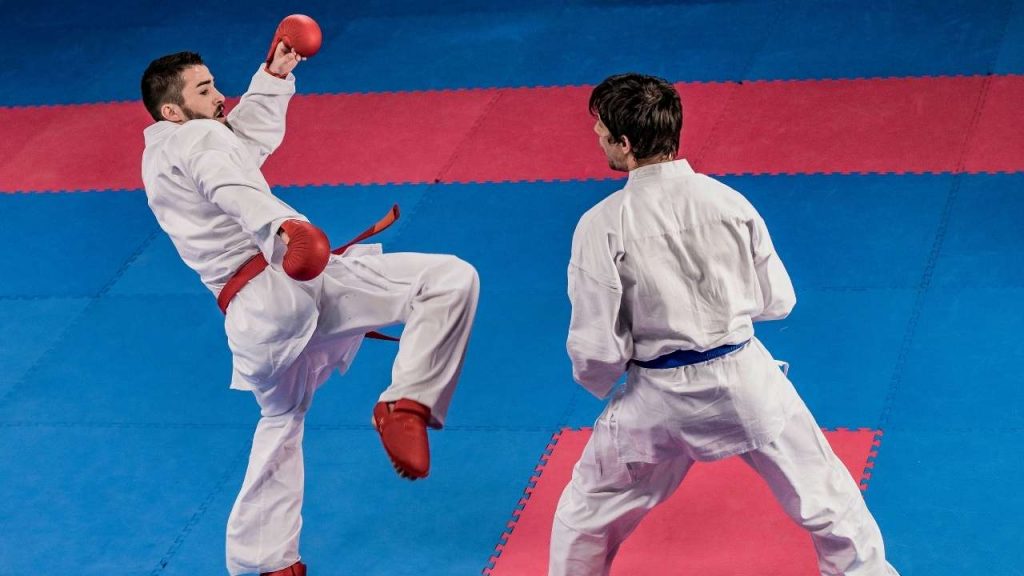
Karate Kata and Kumite in the Olympics
After years of waiting anxiously, Karatekas finally saw their beloved sport debut in the Olympics. In the Tokyo 2020 games (which happened in July-August of 2021), the world’s top competitors in both Kata and Kumite took to the mat to show their stuff.
Kata participants could select from a list of 102 approved kata which they would like to perform. A panel of seven judges used a point system to evaluate their performances to determine the winner.
The judges used the following seven technical points to judge the performances:
- Transitional movements
- Timing
- Stances
- Techniques
- Focus
- Conformance
- Correct breathing
In addition, the judges considered the following three athletic points:
- Speed
- Strength
- Balance
In the men’s division, Ryo Kiyuna of Japan claimed the Gold, followed by Spaniard Damián Quintero who won Silver. Ali Sofuoglu from Turkey and Ariel Torres from the USA shared Bronze.
In the women’s division, the well-known and beloved Spaniard Sandra Sanchez became the first female Olympic champion in Karate Kata. Kiyou Shimizu of Japan stepped up to claim Silver. Viviana Bottaro of Italy and Grace Lau of Hong Kong shared the Bronze.
Kata and Kumite in Karate
It’s pretty incredible when you think about how these ancient martial arts techniques have been preserved and passed down. Though the named art itself of Karate has only existed for less than a hundred years, it is based on a philosophy that stretches back for centuries. Katas have been instrumental in preserving that heritage and helping to pass it down.
And Kumite, though point fighting in competitions has its critics, is an excellent way for students to put their techniques to practice against a live opponent.
Both solidly have their place in the “Way of the Empty Hand” and will continue to be passed down for generations to come.
Curious about the origins of Karate here? Check it out here!


